Chōshi Electric Railway Line
The Chōshi Electric Railway Line (銚子電気鉄道線, Chōshi Denki Tetsudō-sen) is a 6.4 km long railway line operated by the privately owned Chōshi Electric Railway between Chōshi and Tokawa stations in Chiba Prefecture, Japan.[1]
| Choshi Electric Railway Line | |||||||||||||||||||||||||||||||||||||||||||||||||||||||||||||||||||||||||||||
|---|---|---|---|---|---|---|---|---|---|---|---|---|---|---|---|---|---|---|---|---|---|---|---|---|---|---|---|---|---|---|---|---|---|---|---|---|---|---|---|---|---|---|---|---|---|---|---|---|---|---|---|---|---|---|---|---|---|---|---|---|---|---|---|---|---|---|---|---|---|---|---|---|---|---|---|---|---|
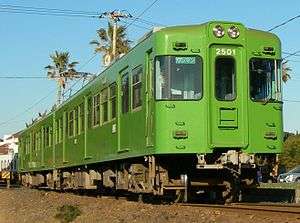 Choshi Electric Railway 2000 series set 2001 in January 2011 | |||||||||||||||||||||||||||||||||||||||||||||||||||||||||||||||||||||||||||||
| Overview | |||||||||||||||||||||||||||||||||||||||||||||||||||||||||||||||||||||||||||||
| Native name | 銚子電気鉄道線 | ||||||||||||||||||||||||||||||||||||||||||||||||||||||||||||||||||||||||||||
| Type | Light rail | ||||||||||||||||||||||||||||||||||||||||||||||||||||||||||||||||||||||||||||
| Status | Operational | ||||||||||||||||||||||||||||||||||||||||||||||||||||||||||||||||||||||||||||
| Locale | Chiba Prefecture | ||||||||||||||||||||||||||||||||||||||||||||||||||||||||||||||||||||||||||||
| Termini | Chōshi Tokawa | ||||||||||||||||||||||||||||||||||||||||||||||||||||||||||||||||||||||||||||
| Stations | 10 | ||||||||||||||||||||||||||||||||||||||||||||||||||||||||||||||||||||||||||||
| Services | 1 | ||||||||||||||||||||||||||||||||||||||||||||||||||||||||||||||||||||||||||||
| Operation | |||||||||||||||||||||||||||||||||||||||||||||||||||||||||||||||||||||||||||||
| Opened | 5 July 1923[1] | ||||||||||||||||||||||||||||||||||||||||||||||||||||||||||||||||||||||||||||
| Owner | Choshi Electric Railway | ||||||||||||||||||||||||||||||||||||||||||||||||||||||||||||||||||||||||||||
| Depot(s) | Nakanochō | ||||||||||||||||||||||||||||||||||||||||||||||||||||||||||||||||||||||||||||
| Rolling stock | 2000 series, 3000 series EMUs | ||||||||||||||||||||||||||||||||||||||||||||||||||||||||||||||||||||||||||||
| Technical | |||||||||||||||||||||||||||||||||||||||||||||||||||||||||||||||||||||||||||||
| Line length | 6.4 km (4.0 mi) | ||||||||||||||||||||||||||||||||||||||||||||||||||||||||||||||||||||||||||||
| Track gauge | 1,067 mm (3 ft 6 in) | ||||||||||||||||||||||||||||||||||||||||||||||||||||||||||||||||||||||||||||
| Electrification | 600 V DC overhead catenary | ||||||||||||||||||||||||||||||||||||||||||||||||||||||||||||||||||||||||||||
| Operating speed | 40 km/h (25 mph)[1] | ||||||||||||||||||||||||||||||||||||||||||||||||||||||||||||||||||||||||||||
| |||||||||||||||||||||||||||||||||||||||||||||||||||||||||||||||||||||||||||||
It is the Chōshi Electric Railway's only line and is facing declining ridership. The company ventured into selling nure-senbei (moist senbei rice crackers) to subsidize its operations, and the profits from confectionery sales are now double those from its railway operations.[2]
Service pattern
All trains stop at all stations, with trains passing on the single line at Kasagami-Kurohae Station. Since 21 November 2013, one train per hour runs during the daytime.[3]
Previously, two to three trains operated per hour throughout the day.[4] In the past, two- or three-car formations were operated on New Year's Day to transport passengers to see the first sunrise of the year at the popular coastal viewing point in Inubōsaki.[5]
Stations
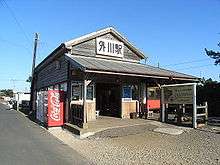
| No. | Station | Japanese | Distance (km) | Distance between stations (km) | Date opened | Location |
|---|---|---|---|---|---|---|
| Chōshi | 銚子 | 0.0 | - | 5 July 1923 | Chōshi, Chiba | |
| Nakanochō | 仲ノ町 | 0.5 | 0.5 | 5 July 1923 | ||
| Kannon | 観音 | 1.1 | 0.6 | 5 July 1923 | ||
| Moto-Chōshi | 本銚子 | 1.8 | 0.7 | 5 July 1923 | ||
| Kasagami-Kurohae | 笠上黒生 | 2.7 | 0.9 | 1 July 1925 | ||
| Nishi-Ashikajima | 西海鹿島 | 3.2 | 0.5 | 1 March 1970 | ||
| Ashikajima | 海鹿島 | 3.6 | 0.4 | 5 July 1923 | ||
| Kimigahama | 君ヶ浜 | 4.7 | 1.1 | 21 June 1931 | ||
| Inuboh | 犬吠 | 5.5 | 0.8 | 1 September 1935 | ||
| Tokawa | 外川 | 6.4 | 0.9 | 5 July 1923 |
Rolling stock
- 2000 series 2-car EMUs (x2, since 24 July 2010), former Iyo Railway 800 series (originally Keio Corporation 2010 series built in 1962)[5]
- 3000 series 2-car EMU (since 26 March 2016), former Iyo Railway 700 series (originally Keio 5000 series)
- DeKi 3 electric locomotive, built in 1922 by AEG in Germany, based at Nakanochō Depot
- 2000 series set 2002 in October 2015
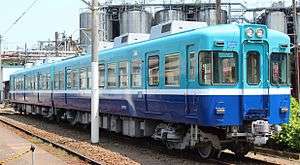 3000 series set 3001 in May 2016
3000 series set 3001 in May 2016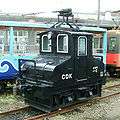 "DeKi 3" electric locomotive in December 2006
"DeKi 3" electric locomotive in December 2006
In 2007, it was announced that former Keio 3000 series stainless steel EMUs converted to 2-car sets would be purchased to replace the three vintage 700 and 800 series cars still in operation. This plan was however cancelled due to the cost of converting the 1,500 V DC cars to 600 V DC operation. Instead, two pairs of former Iyo Railway 800 series EMU cars were purchased in 2009, and these entered service in July 2010 following conversion work, becoming the 2000 series.[5]
In September 2015, a two-car 700 series EMU was purchased from the Iyo Railway for 1.3 million yen.[6] The train entered service on the line in March 2016, following repainting into a two-tone blue livery.[7]
Past rolling stock
- 0-6-0T steam locomotives 1 and 2 (former JNR 1102 and 1107) (Choshi Sightseeing Railway, December 1913 - November 1917)
- Ro 1, RoHa 1, Ha 1, HaNi 1 4-wheel coaches (Choshi Sightseeing Railway, December 1913 - November 1917)
- HaFu 1 and HaFu 2 non-powered trailer cars, withdrawn in September 1978 and cut up in 1979[8]
- 100 series EMU car DeHa 101, built 1939, withdrawn in 1999, and scrapped in September 2009[5][9]
- 200 series EMU car DeHa 201, (former Keisei MoNi 7, built in 1925), operated from 1949 until 1978,[9] and officially withdrawn in 1979[8]
- 300 series EMU car DeHa 301 (former Tsurumi Rinkō Railway MoHa 115, built in 1930), operated from 1951, withdrawn in 2008, scrapped in October 2009[8]
- 500 series EMU car DeHa 501 (former Ueda Kōtsū MoHa 2321, built in 1939), operated from 1972, later sectioned at Inuboh Station,[9] and cut up on-site in July 2012[10]
- 700 series EMU car DeHa 701 (former Ohmi Railway MoHa 50 built in 1942), withdrawn in September 2010
- 700 series EMU car DeHa 702 (former Ohmi Railway MoHa 50, built 1942), withdrawn in January 2010
- 800 series EMU car DeHa 801 (former Iyo Railway MoHa 106 built in 1950), withdrawn in September 2010
- Yu 101 open car, (former WaMu 80000 freight car number WaMu 183983, built in 1969), operated from 4 August 1985, but taken out of service since 2004 due to safety regulations, and stored first at Tokawa Station and then at Kasagami-Kurohae Station[5][11] before being official withdrawn on 30 June 2012[12]
- 1000 series EMU car 1001 (former TRTA 2000 series built in 1960), withdrawn in February 2016
- 1000 series EMU car 1002 (former TRTA 2000 series built in 1959), withdrawn in February 2015[13]
- Withdrawn car DeHa 101 in December 2006
- DeHa 301 in December 2006
 700 series car DeHa 701 in March 2010
700 series car DeHa 701 in March 2010 DeHa 702 in March 2008
DeHa 702 in March 2008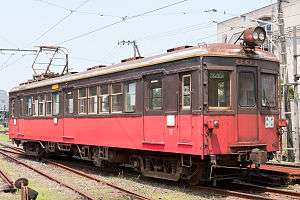 800 series car DeHa 801 in July 2010
800 series car DeHa 801 in July 2010- Yu 101 stored at Tokawa Station in January 2007
 1000 series car DeHa 1001 in December 2012
1000 series car DeHa 1001 in December 2012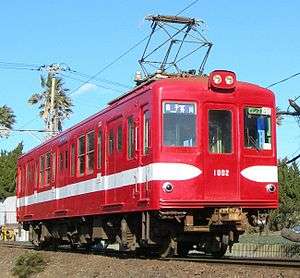 1000 series car DeHa 1002 in January 2012
1000 series car DeHa 1002 in January 2012
History
Chōshi Sightseeing Railway (1913-1917)
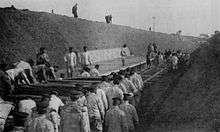
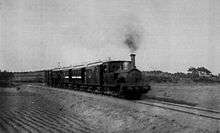
The predecessor to the present-day line opened on 28 December 1913 as the Chōshi Sightseeing Railway (銚子遊覧鉄道, Chōshi Yūran Tetsudō), operating a distance of 5.9 km between Chōshi and Inuboh using steam haulage.[14] The 1,067 mm (3 ft 6 in) gauge line was laid by a team of 235 army engineers in just 11 days.[14] There were four intermediate stations, at Nakanocho, Kannon, Moto-Choshi, and Ashikajima, and by 1914, eight return services operated daily, with journeys taking 23 minutes.[14] The line used two former JNR 0-6-0T steam locomotives built by Nasmyth, Wilson in the UK.[14] These were numbered 1 and 2 (former JNR numbers 1102 and 1107 respectively).[14]
Faced with poor ridership figures and increases in material costs caused by the outset of the First World War, the operating company announced its intention to close the line and sell off the infrastructure. This was met with violent protests from local residents, which resulted in the arrest of three people, recorded as the first public protest against railway closure plans in Japan.[14] Despite the protests, the railway company terminated services on the line from the afternoon of 20 November 1917, and formally closed the line as of 30 November.[14] The line's trackbed was converted to a dedicated bus route,[9] but the station buildings remained intact.[14] The two steam locomotives, 1 and 2, were sold to Yawata Steel Works, where they were renumbered 200 and 201, and operated until after the Second World War.[14] The line's four passenger coaches were sold to the Rikuu Railway (now part of the JR Gono Line) in Aomori Prefecture, ultimately becoming numbers Ro 790, Ha 2555, Ha 2556, and HaNi 3680 in JNR days.[14]
Chōshi Railway (1922-1948)
On 10 October 1922, the Chōshi Railway Company (銚子鉄道株式会社, Chōshi Tetsudō Kabushikigaisha) was formed, and the line was reopened from 5 July 1923 using the former Chōshi Sightseeing Railway trackbed and structures between Chōshi and Inuboh Stations, with an extension south to Tokawa. Rolling stock consisted of two petrol-engined locomotives and two two-axle carriages. The locomotives proved unreliable, however, and the line was electrified at 600 V DC from 1 July 1925, with a fleet of three electric cars purchased from the former Ina Electric Railway (伊那電気鉄道, Ina Denki Tetsudō) (present-day JR Iida Line).[1][9]
Services on the line were suspended from 20 July 1945, following air raid damage. A C class steam tank locomotive was borrowed from JNR to resume operations on the line from December 1945, and electric train operations resumed from 4 April 1946.[1][9]
Chōshi Electric Railway (1948-)
On 20 August 1948, the operating company was renamed Chōshi Electric Railway (銚子遊覧鉄道, Chōshi Denki Tetsudō).[1]
In 1956, a private track was laid directly from Chōshi Station to the nearby Yamasa soy sauce factory, which virtually eliminated freight operations handled by the Chōshi Electric Railway. In 1963, a decision was made to close the line, but this decision was overturned following opposition from the local communities and funding from Chōshi City. To the present day, the line is largely subsidized by Chiba Prefecture and Chōshi City.[9]
Freight operations on the line were discontinued from 1 February 1984.[1] From 1 April 1995, operations on the line switched to wanman driver-only operation.[9]
From 21 November 2013, services were cut back from two trains per hour to one train per hour during the daytime.[3]
Accidents
A head-on collision occurred in June 1995 north of Kasagami-Kurohae Station between DeHa 701 on a down (Tokawa-bound) service and DeHa 1001 on an up (Chōshi-bound) service. Both cars sustained front-end damage. DeHa 701 was returned to service in April 1996 following repairs and repainting back into the standard livery of dark brown and red.[5]
On 11 January 2014, at 08:19, 2000 series 2-car EMU set 2002 from Tokawa to Choshi derailed on points on the approach to Kasagami-Kurohae Station.[15][16] Two of the train's bogies were derailed, but the train remained upright and none of the nine passengers on board was injured.[17]
Passenger statistics
The annual passenger statistics for past years are as shown below.[8]
| Fiscal year | Passengers per year |
|---|---|
| 1955 | 1,740,000 |
| 1960 | 1,604,000 |
| 1965 | 1,609,000 |
| 1970 | 1,364,000 |
| 1975 | 1,550,000 |
| 1980 | 1,454,000 |
| 1985 | 1,336,000 |
| 1990 | 1,031,000 |
| 1995 | 932,000 |
| 2000 | 739,000 |
| 2005 | 654,000 |
| 2009 | 714,000 |
In popular culture
Tokawa Station on the line was used as a filming location for the 1985 NHK TV drama series Miotsukushi (澪つくし).[18]
The line formed the backdrop for the 2015 novel Tomoshibi: Choshi Dentetsu no Chiisa na Kiseki (トモシビ-銚子電鉄の小さな奇蹟) written by Midori Yoshino. The book was made into a film, titled Tomoshibi (トモシビ-銚子電鉄の小さな奇蹟), scheduled to be released in Japan in 2017.[19]
In fiction
Makeni Tramway in Sierra Leone uses Choshi Electric Railway EMU and electric locomotive in Train Simulator 2017.
References
- Terada, Hirokazu (July 2002). データブック日本の私鉄 [Databook: Japan's Private Railways]. Japan: Neko Publishing. ISBN 4-87366-874-3.
- ぬれ煎餅でローカル線を救え!~銚子電鉄 [Choshi Electric Railway: Saving a local line with moist senbei!]. All About Archives (in Japanese). All About, Inc. 23 November 2006. Archived from the original on 16 May 2011. Retrieved 1 December 2010.
- 【銚子電気鉄道】11月21日にダイヤ改正実施へ [Choshi Electric Railway to implement revised timetable from 21 November]. RM News (in Japanese). Japan: Neko Publishing Ltd. 21 October 2013. Retrieved 12 January 2014.
- "Timetable" (PDF) (in Japanese). Choshi Electric Railway. 10 December 2005. Archived from the original (PDF) on 23 June 2007. Retrieved 1 December 2010.
- Satō, Toshio (December 2009). 銚子電鉄の電車たちを訪ねて [Visiting the trains of the Chōshi Electric Railway]. Japan Railfan Magazine (in Japanese). Vol. 49 no. 584. Japan: Koyusha Co., Ltd. pp. 92–96.
- 銚子電鉄の更新車両“水揚げ” 伊予鉄道から購入、銚子漁港に到着 千葉 [New Choshi Electric Railway cars unloaded - Arrival in Chiba after purchase from Iyo Railway]. Sankei News (in Japanese). Japan: The Sankei Shimbun & Sankei Digital. 16 September 2015. Retrieved 17 September 2015.
- 澪つくしカラーで親しみ 銚子電鉄 【新型車両デビュー】 [New Choshi Electric Railway train debuts in well-loved "Miotsukushi" livery]. Chiba Nippo (in Japanese). Japan: Chiba Nippo Co., Ltd. 24 March 2016. Retrieved 26 March 2016.
- Terada, Hirokazu (September 2013). 日本のローカル私鉄 30年前の残照を訪ねて その7 [Japan's rural private railways: Revisiting the afterglow of 30 years ago (Part 7)]. Japan Railfan Magazine (in Japanese). Vol. 53 no. 629. Japan: Koyusha Co., Ltd. pp. 98–103.
- Terada, Hirokazu (October 1999). ローカル私鉄探訪 [Exploring Rural Private Railways]. Japan: Shin-Jinbutsuoraisha Co., Ltd. pp. 35–37. ISBN 4-404-02732-X.
- デハ501、元相模鉄道モニ2022 解体 [DeHa 501 and former Sotetsu MoNi 2022 cut up]. RM News (in Japanese). Japan: Neko Publishing Co., Ltd. 26 July 2012. Retrieved 12 August 2012.
- Okada, Seiichi (June 2012). ザ・客車 一般形と事業車の現状2 [Passenger Coaches - The Current State of Regular and Non-revenue Vehicles 2]. Japan Railfan Magazine. Vol. 52 no. 614. Japan: Koyusha Co., Ltd. p. 119.
- 私鉄車両編成表 2013 [Private Railway Rolling Stock Formations - 2013]. Japan: Kotsu Shimbunsha. 30 July 2013. p. 202. ISBN 978-4-330-39313-1.
- 銚子電気鉄道「ありがとうデハ1002号」運転 ["Thank you 1002" service runs on Choshi Electric Railway]. Tetsudō Daiya Jōhō Magazine (in Japanese). Vol. 44 no. 371. Japan: Kōtsū Shimbun. March 2015. p. 79.
- Shirato, Sadao (March 2014). 銚子遊覧鉄道 [Chōshi Sightseeing Railway]. The Railway Pictorial (in Japanese). Japan: Denkisha Kenkyūkai. 64 (887): 108–109.
- 銚子電鉄:電車が脱線、乗客けがなし…笠上黒生駅 [Choshi Electric Railway train derails at Kasagami-Kurohae Station - No passengers injured]. Mainichi Shimbun (in Japanese). Japan: The Mainichi Newspapers. 11 January 2014. Archived from the original on 11 January 2014. Retrieved 11 January 2014.
- 銚子電鉄 笠上黒生駅付近で発生した列車脱線事故について [Choshi Electric Railway: Details of derailment near Kasagami-Kurohae Station] (PDF). New release (in Japanese). Japan: Choshi Electric Railway. 11 January 2014. Archived from the original (PDF) on 12 January 2014. Retrieved 12 January 2014.
- 銚子電鉄 脱線で運転取りやめ [Choshi Electric Railway: Services suspended due to derailment]. NHK News Web (in Japanese). Japan: NHK. 11 January 2014. Archived from the original on 12 January 2014. Retrieved 12 January 2014.
- Shirato, Sadao (June 2011). 銚子電気鉄道(上) [Choshi Electric Railway Volume One]. Japan: Neko Publishing Co., Ltd. p. 32. ISBN 978-4-7770-5309-4.
- 銚子電鉄を舞台にした小説「トモシビ」を映画化 [Novel Tomoshibi featuring Choshi Electric Railway to be made into a film]. Japan Railfan Magazine Online (in Japanese). Japan: Koyusha Co., Ltd. 1 November 2016. Archived from the original on 2 November 2016. Retrieved 2 November 2016.
External links
| Wikimedia Commons has media related to Choshi Electric Railway. |
- Chōshi Electric Railway official website (in Japanese)
- Chōshi Electric Railway official web shop (in Japanese)